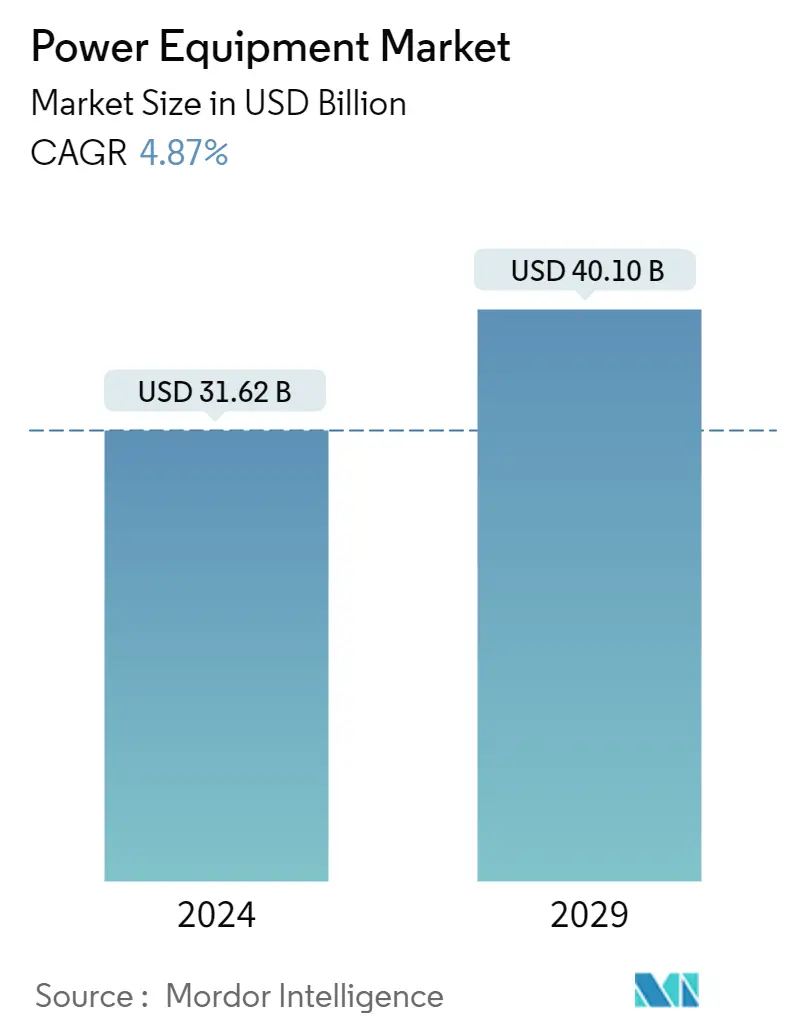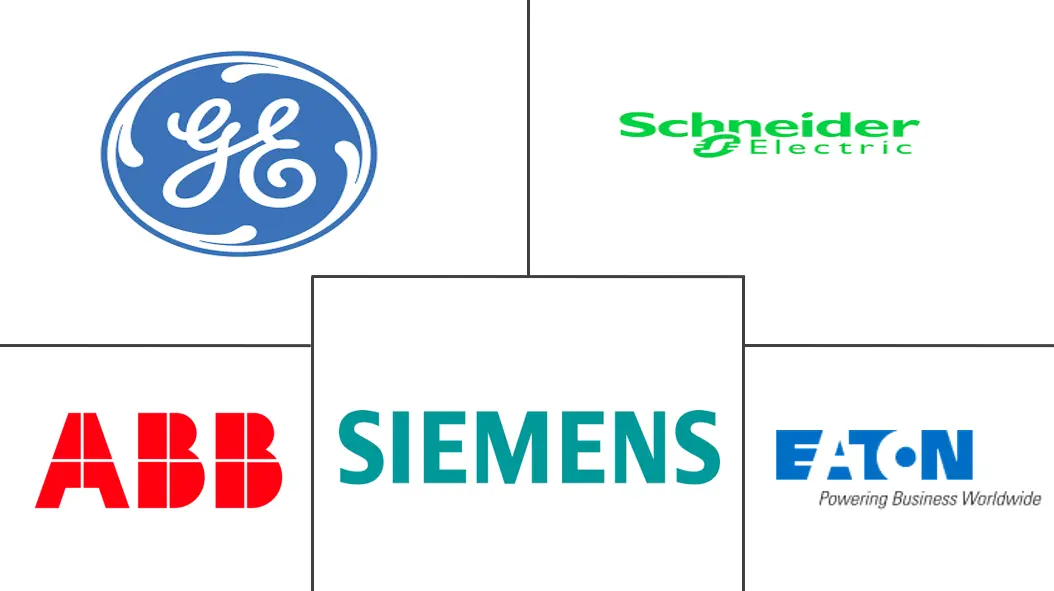Market Size of Power Equipment Industry

| Study Period | 2020 - 2029 |
| Market Size (2024) | USD 31.62 Billion |
| Market Size (2029) | USD 40.10 Billion |
| CAGR (2024 - 2029) | 4.87 % |
| Fastest Growing Market | Asia Pacific |
| Largest Market | North America |
| Market Concentration | Low |
Major Players
*Disclaimer: Major Players sorted in no particular order |
Power Equipment Market Analysis
The Power Equipment Market size is estimated at USD 31.62 billion in 2024, and is expected to reach USD 40.10 billion by 2029, growing at a CAGR of 4.87% during the forecast period (2024-2029).
COVID-19 negatively impacted the market in 2020. Presently, the market has reached pre-pandemic levels.
- Over the medium term, increasing population growth and infrastructure development are expected to increase energy demand, consequently increasing the demand for power equipment during the forecasted period.
- On the other hand, high operations and maintenance costs are expected to hinder market growth.
- Nevertheless, the increasing technological investments in developing renewable energy and smart grid infrastructure are expected to create huge opportunities for the power equipment market.
Power Equipment Industry Segmentation
Power equipment refers to a wide range of devices, machinery, and components that generate, transmit, and distribute electrical power. These pieces of equipment play vital roles in ensuring power systems' reliable and efficient operation.
The power equipment market is segmented by equipment type, power generation source, end-user, application, and geography (North America, Asia-Pacific, Europe, South America, the Middle East, and Africa). The market is segmented by equipment type into generators, transformers, switchgear, circuit breakers, power cables, and other equipment types. By power generation sources, the market is segmented into fossil fuels, solar, wind, nuclear, and hydro. By end user, the market is segmented into residential, industrial, commercial, and utility. The market is segmented by application into generation, transmission, and distribution. The report also covers the market size and forecasts for the power equipment market across major regions, such as Asia-Pacific, North America, Europe, South America, the Middle East, and Africa. Market sizing and forecasts have been done for each segment based on revenue (USD).
| Equipment Type | |
| Generator | |
| Transformer | |
| Switchgears | |
| Circuit Breakers | |
| Power Cable | |
| Other Equipment Types |
| Power Generation Source | |
| Fossil Fuel Based | |
| Solar | |
| Wind | |
| Nuclear | |
| Hydro |
| End-User | |
| Residential | |
| Industrial and Commercial | |
| Utility |
| Application | |
| Power Generation | |
| Transmission | |
| Distribution |
| Geography [Market Size and Demand Forecast till 2028 (for regions only)] | |||||||
| |||||||
| |||||||
| |||||||
| |||||||
|
Power Equipment Market Size Summary
The power equipment market is poised for significant growth over the forecast period, driven by increasing energy demand due to population growth, urbanization, and industrialization. The market is recovering from the COVID-19 pandemic's impact and is expected to expand as infrastructure development accelerates. However, high operational and maintenance costs pose challenges to market growth. Despite these hurdles, technological advancements in renewable energy and smart grid infrastructure present substantial opportunities. The global shift towards renewable energy sources, such as solar, wind, hydro, and geothermal power, underscores the critical role of power generation equipment in meeting rising electricity demand and ensuring a sustainable energy future.
The Asia-Pacific region is anticipated to emerge as a key player in the power equipment market, fueled by rapid population growth, industrialization, and increased access to electricity. Countries like China, India, Japan, and Australia are expected to drive market dynamics through the adoption of renewable energy sources and improvements in power grid infrastructure. Government initiatives and investments in energy security and renewable energy further bolster demand in the region. The market is semi-consolidated, with major players like General Electric Company, Schneider SE, ABB Ltd., Eaton Corporation, and Siemens AG leading the charge. Recent developments, such as CAT's launch of advanced power equipment and India's manufacturing zone initiative, highlight ongoing innovations and strategic efforts to enhance power equipment capabilities.
Power Equipment Market Size - Table of Contents
-
1. MARKET OVERVIEW
-
1.1 Introduction
-
1.2 Market Size and Demand Forecast in USD, till 2028
-
1.3 Recent Trends and Developments
-
1.4 Government Policies and Regulations
-
1.5 Market Dynamics
-
1.5.1 Drivers
-
1.5.1.1 Increasing Population Growth and Infrastructure Development
-
-
1.5.2 Restraints
-
1.5.2.1 High Operational and Maintenance Costs
-
-
-
1.6 Supply Chain Analysis
-
1.7 Industry Attractiveness - Porter's Five Forces Analysis
-
1.7.1 Bargaining Power of Suppliers
-
1.7.2 Bargaining Power of Consumers
-
1.7.3 Threat of New Entrants
-
1.7.4 Threat of Substitutes Products and Services
-
1.7.5 Intensity of Competitive Rivalry
-
-
-
2. MARKET SEGMENTATION
-
2.1 Equipment Type
-
2.1.1 Generator
-
2.1.2 Transformer
-
2.1.3 Switchgears
-
2.1.4 Circuit Breakers
-
2.1.5 Power Cable
-
2.1.6 Other Equipment Types
-
-
2.2 Power Generation Source
-
2.2.1 Fossil Fuel Based
-
2.2.2 Solar
-
2.2.3 Wind
-
2.2.4 Nuclear
-
2.2.5 Hydro
-
-
2.3 End-User
-
2.3.1 Residential
-
2.3.2 Industrial and Commercial
-
2.3.3 Utility
-
-
2.4 Application
-
2.4.1 Power Generation
-
2.4.2 Transmission
-
2.4.3 Distribution
-
-
2.5 Geography [Market Size and Demand Forecast till 2028 (for regions only)]
-
2.5.1 North America
-
2.5.1.1 United States
-
2.5.1.2 Canada
-
2.5.1.3 Rest of North America
-
-
2.5.2 Europe
-
2.5.2.1 Germany
-
2.5.2.2 France
-
2.5.2.3 United Kingdom
-
2.5.2.4 Russia
-
2.5.2.5 Rest of Europe
-
-
2.5.3 Asia-Pacific
-
2.5.3.1 China
-
2.5.3.2 India
-
2.5.3.3 Australia
-
2.5.3.4 Japan
-
2.5.3.5 Rest of Asia-Pacific
-
-
2.5.4 Middle East and Africa
-
2.5.4.1 Saudi Arabia
-
2.5.4.2 United Arab Emirates
-
2.5.4.3 Nigeria
-
2.5.4.4 South Africa
-
2.5.4.5 Rest of Middle East and Africa
-
-
2.5.5 South America
-
2.5.5.1 Brazil
-
2.5.5.2 Argentina
-
2.5.5.3 Chile
-
2.5.5.4 Rest of South America
-
-
-
Power Equipment Market Size FAQs
How big is the Power Equipment Market?
The Power Equipment Market size is expected to reach USD 31.62 billion in 2024 and grow at a CAGR of 4.87% to reach USD 40.10 billion by 2029.
What is the current Power Equipment Market size?
In 2024, the Power Equipment Market size is expected to reach USD 31.62 billion.

